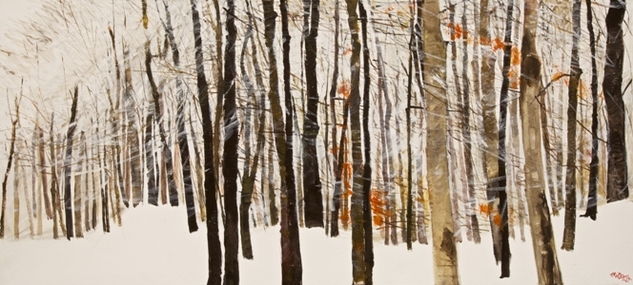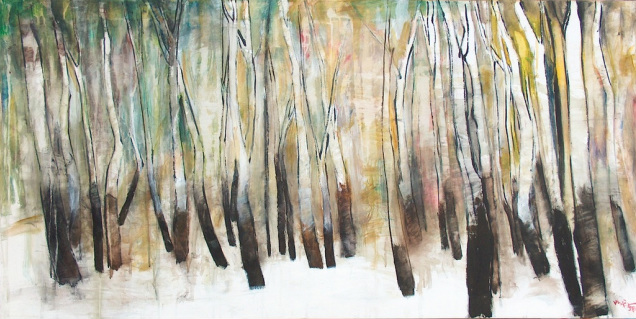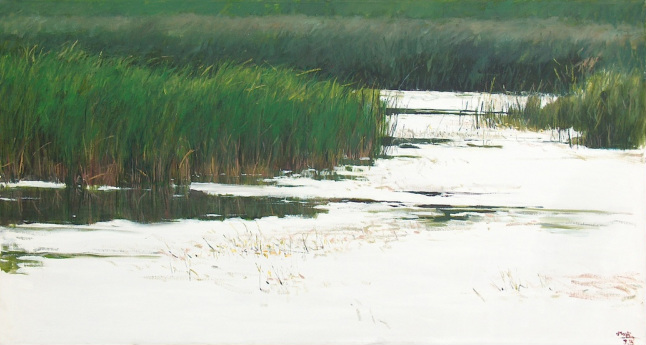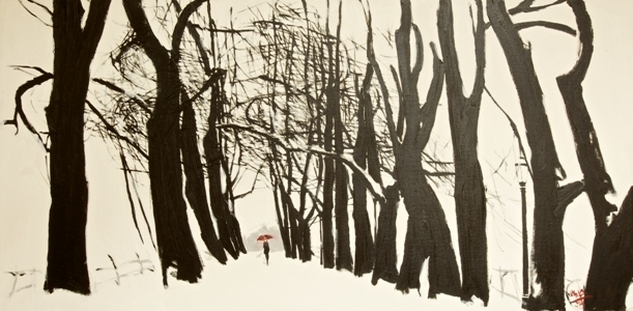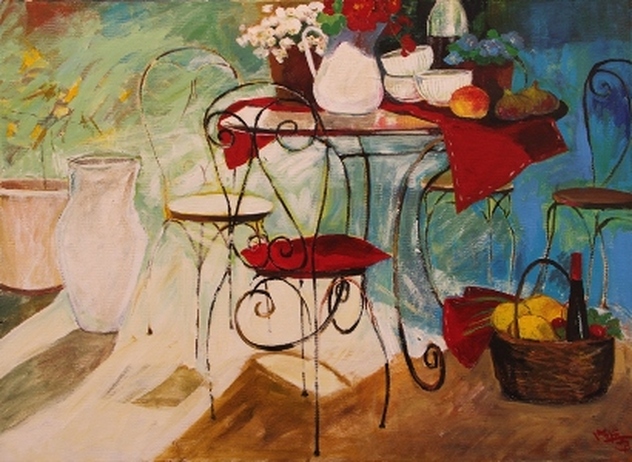Ji Suk Baek (Jessy Baek) - ulja na platnu
Životopis
Ji Suk Baek rođena je 1966. u Južnoj Koreji. U srednjoj školi primila je brojne nagrade na likovnim natjecanjima. Primljena je na Likovnu akademiju u Seulu 1985., a diplomirala 1989. godine. Iste te godine sudjelovala je na izložbi Najtalentiraniji mladi umjetnici u Koreji.
Osnovala je obitelj u Zagrebu 1995.
Ime Jessy odabrala je zbog sličnosti sa svojim pravim imenom, a zbog lakšeg izgovaranja za Europljane.
Prvu samostalnu izložbu s 30 portreta djece izbjeglica iz Vukovara imala je u izbjegličkom kampu na Črnomercu. Kao članica Međunarodnog kluba žena 1999. godine sudjelovala je na skupnoj izložbi u Galeriji “Mirko Virius”. Njezina druga samostalna izložba održana je od 16. do 30.05.2003. godine u Kulturnom centru Centra Kaptol. Nekoliko samostalnih izložbi imala je u Knjižnici i čitaonici Bogdana Ogrizovića, Knjižnici Staglišće i Knjižnici Augusta Cesarca od 2005. do 2011. U rujnu 2008. samostalna izložba održana je u Centru za kulturu i obrazovanje Susedgrad, a u listopadu 2008. u Galeriji Pegaz, Osijek, s temom “Trenutak”.
Sudionica je skupnih izložbi “Likumove generacije“ tijekom 2010. i 2011. U zadnjih 10 godina podučavala je brojnu talentiranu djecu u Internacionalnoj američkoj školi, Francuskoj školi u Zagrebu, Njemačkoj internacionalnoj školi i svom ateljeu.
Članica je HDLU-a (Hrvatskog društva likovnih umjetnika) i LIKUM-a (Zadruge likovnih umjetnika).
Osnovala je obitelj u Zagrebu 1995.
Ime Jessy odabrala je zbog sličnosti sa svojim pravim imenom, a zbog lakšeg izgovaranja za Europljane.
Prvu samostalnu izložbu s 30 portreta djece izbjeglica iz Vukovara imala je u izbjegličkom kampu na Črnomercu. Kao članica Međunarodnog kluba žena 1999. godine sudjelovala je na skupnoj izložbi u Galeriji “Mirko Virius”. Njezina druga samostalna izložba održana je od 16. do 30.05.2003. godine u Kulturnom centru Centra Kaptol. Nekoliko samostalnih izložbi imala je u Knjižnici i čitaonici Bogdana Ogrizovića, Knjižnici Staglišće i Knjižnici Augusta Cesarca od 2005. do 2011. U rujnu 2008. samostalna izložba održana je u Centru za kulturu i obrazovanje Susedgrad, a u listopadu 2008. u Galeriji Pegaz, Osijek, s temom “Trenutak”.
Sudionica je skupnih izložbi “Likumove generacije“ tijekom 2010. i 2011. U zadnjih 10 godina podučavala je brojnu talentiranu djecu u Internacionalnoj američkoj školi, Francuskoj školi u Zagrebu, Njemačkoj internacionalnoj školi i svom ateljeu.
Članica je HDLU-a (Hrvatskog društva likovnih umjetnika) i LIKUM-a (Zadruge likovnih umjetnika).
O autorici
Krajolik kao motivsko polazište slikarskog izraza moguće je sagledati kroz raznolike autorske inačice:
od sirovog realizma, plošnog redukcionizma, pa sve do aluzivne poetizacije i rubnog područja apstrakcije.
Spektar je dakako puno širi. Presudna je likovna osjetljivost autorice u standardizaciji izražajnih
mogućnosti.
Slikarica Jessy Baek (pravim imenom Ji Suk Baek) dolazi nam s Dalekog Istoka, iz Južne Koreje, ali
po svojem stvarnom slikarskom ishodištu bliska je opservacijskom redukcionizmu europske baštine
(iako ne možemo izložiti sve utjecaje na slikaricu ipak se ne smije zanemariti estetska podloga plošnog grafičkog izraza istog tog Istoka).
Slika tako autorica “osjećanje prirode“ pribrano i britko komponirajući preglednost plošnine.
Kist i oko zahvaćaju stvari svodljive na jednostavnost akromatskih i kromatskih odnosa. Ekonomija
široko položene boje omogućava joj zasićeni trenutak kromatskog naglaska, ukošenost ritmičkih
grafizama, oplošnjenja prostornih jedinica. Tonska stabilnost plohe kao i njezino prosijavanje kroz crtačku oštrinu učinkovito kontrastiraju planove. Modelacijski tretman forme zamijenjen je oplošnjenjima koja procesuiraju konzekventni učinak.
Bistra oštrina plohe određuje “dignitet“ prirode u pojedinačnoj pojavnosti, a ukupnost rasporeda boje i linija kristaliziraju čitkost kompozicije. Boje na njezinim slikama imaju ponešto od grafičke zasićenosti i kolorističke elementarnosti, ali se ove dvije komponente sretno združuju u valerni odnos. U slobodnijim partijama slike autorica je odledila svoju samokontrolu vrckastim duktusom.
To je pogodovalo da šume i širi krajolici oglase ravnotežu racionalnog i osjećajnog polariteta.
Ne skrećući u deformaciju održala je i ostvarila zdravu likovnu potrebu da proporcionira vidljiv
svijet u sugestivni slikarski organizam. Slikarski doživljaj prirode kreirala je beskompromisno s darovitošću inteligentnog senzibiliteta koji afirmira njezine mogućnosti. Plošna koncepcija njezinog slikarskog rada po svojoj je tonskoj sažetosti i gledljivosti prilog suvremenom pejzažnom slikarstvu u smislu njegovog trajanja na razini likovne pismenosti.
Dolazeći iz daleka, Jessy Baek postaje nam bliska, sada već dio našeg kulturnog krajolika. A to je uspjeh koji treba respektirati.
Danijel Žabčić
od sirovog realizma, plošnog redukcionizma, pa sve do aluzivne poetizacije i rubnog područja apstrakcije.
Spektar je dakako puno širi. Presudna je likovna osjetljivost autorice u standardizaciji izražajnih
mogućnosti.
Slikarica Jessy Baek (pravim imenom Ji Suk Baek) dolazi nam s Dalekog Istoka, iz Južne Koreje, ali
po svojem stvarnom slikarskom ishodištu bliska je opservacijskom redukcionizmu europske baštine
(iako ne možemo izložiti sve utjecaje na slikaricu ipak se ne smije zanemariti estetska podloga plošnog grafičkog izraza istog tog Istoka).
Slika tako autorica “osjećanje prirode“ pribrano i britko komponirajući preglednost plošnine.
Kist i oko zahvaćaju stvari svodljive na jednostavnost akromatskih i kromatskih odnosa. Ekonomija
široko položene boje omogućava joj zasićeni trenutak kromatskog naglaska, ukošenost ritmičkih
grafizama, oplošnjenja prostornih jedinica. Tonska stabilnost plohe kao i njezino prosijavanje kroz crtačku oštrinu učinkovito kontrastiraju planove. Modelacijski tretman forme zamijenjen je oplošnjenjima koja procesuiraju konzekventni učinak.
Bistra oštrina plohe određuje “dignitet“ prirode u pojedinačnoj pojavnosti, a ukupnost rasporeda boje i linija kristaliziraju čitkost kompozicije. Boje na njezinim slikama imaju ponešto od grafičke zasićenosti i kolorističke elementarnosti, ali se ove dvije komponente sretno združuju u valerni odnos. U slobodnijim partijama slike autorica je odledila svoju samokontrolu vrckastim duktusom.
To je pogodovalo da šume i širi krajolici oglase ravnotežu racionalnog i osjećajnog polariteta.
Ne skrećući u deformaciju održala je i ostvarila zdravu likovnu potrebu da proporcionira vidljiv
svijet u sugestivni slikarski organizam. Slikarski doživljaj prirode kreirala je beskompromisno s darovitošću inteligentnog senzibiliteta koji afirmira njezine mogućnosti. Plošna koncepcija njezinog slikarskog rada po svojoj je tonskoj sažetosti i gledljivosti prilog suvremenom pejzažnom slikarstvu u smislu njegovog trajanja na razini likovne pismenosti.
Dolazeći iz daleka, Jessy Baek postaje nam bliska, sada već dio našeg kulturnog krajolika. A to je uspjeh koji treba respektirati.
Danijel Žabčić
Izložba u Galeriji Toš, Punat 03.08.2012.:
Biography
Ji Suk Baek was born in 1966 in South Korea. During her high school
education she received numerous awards at visual art competitions.
She was admitted to the Academy of Fine Arts in 1985 from which she
graduated in 1989. That same year she participated at the exhibition
The Most Talented Young Artists in Korea.
She founded a family in Zagreb in 1995.
She hosted her first independent exhibition with 30 portraits of the children refugees from Vukovar in refugee camp at Črnomerec, Zagreb. As a member of the International Club of Women she took part at collective exhibition in the Gallery “Mirko Virius“ in 1999.
Her second independent exhibition was from 16 – 30 May 2003 in the Cultural Centre Kaptol. From 2005 till 2011 she held several independent exhibitions in the Library and Reading Room Bogdan Ogrizović, Library Staglišće and Library August Cesarec. In September 2008 her independent exhibition was held in the Centre for Culture and Education Susedgrad and in October 2008 in Gallery Pegaz, in Osijek, on the topic “Moment“.
She participated at collective exhibitions of the “Likum’s Generation“ during 2010 and 2011. For the past 10 years she trained numerous talented children at International American School, French School in Zagreb, German International School and in her studio.
She is member of the HDLU (Croatian Society of Artists), of LIKUM (Croatian Visual Artists Associa-
tion).
She founded a family in Zagreb in 1995.
She hosted her first independent exhibition with 30 portraits of the children refugees from Vukovar in refugee camp at Črnomerec, Zagreb. As a member of the International Club of Women she took part at collective exhibition in the Gallery “Mirko Virius“ in 1999.
Her second independent exhibition was from 16 – 30 May 2003 in the Cultural Centre Kaptol. From 2005 till 2011 she held several independent exhibitions in the Library and Reading Room Bogdan Ogrizović, Library Staglišće and Library August Cesarec. In September 2008 her independent exhibition was held in the Centre for Culture and Education Susedgrad and in October 2008 in Gallery Pegaz, in Osijek, on the topic “Moment“.
She participated at collective exhibitions of the “Likum’s Generation“ during 2010 and 2011. For the past 10 years she trained numerous talented children at International American School, French School in Zagreb, German International School and in her studio.
She is member of the HDLU (Croatian Society of Artists), of LIKUM (Croatian Visual Artists Associa-
tion).
About her paintings
It is possible to observe the scenery as motive starting point of the painting-expression through various author’s variations: from raw realism, planar reductionism, to allusive poetization and border-area of abstraction. Of course, the spectrum is much broader. Decisive is the author’s painting-sensitivity in the standardization of the expressive possibilities.
The painter Jessy Baek (Ji Suk Baek) comes from the Far East, South Korea, but according to her real painting-origin is close to observation reductionism of the European heritage (al though we can not put through all influences on the painter, we still can not neglect the aesthetic basis of the planar graphical expression of that same East).
The painter thus paints “the sensation of nature“ componing the good layout of the plane keenly and with self-possession. The artist’s brush and the eye get hold of things reducible to the simplicity of the achromatic and chromatic relationships. The economy of the widely laid down colour provides her with a saturated moment of the chromatic emphasis, the slantness of the rhythmical graphisms, the organization of spatial units. The tonal stability of the surface as well as its sifting through the drawer’s sharpness efficiently contrasts the plans. The modelation treatment of the form has been replaced with spatial organizations that process the consequential effect.
The limpid sharpness of the plane determines the “dignity“ of the nature in individual appearance, and the entirety of the arrangement of the colour and lines crystallize the readability of the composition.
The colours on her paintings have somewhat of graphical saturation and coloristic elementarity, but
these two components are happily brought together in a valuable relationship. In freer parts of the
painting the author has unfreezed her self-control with play ful ductus.
That favoured that forests and wider sceneries made an utterance of the rational and emotional polarity.
Not swerving into deformation, she has maintained and realized a sound painting-need to prorate the visible world into a suggestive painting organism. She created the painting experience of the nature without compromise with talents of an intelligent perceptiveness that establishes her capabilities.
The planar concept of her painting-work, according to its tonal conciseness and the possibility of
observation, is in favour of the contemporary scenery-art of painting in terms of its duration at the level of painting literacy. Having come from afar, Jessy Baek has become close to us, and is now already a part of our cultural scenery. That is a success that should be respected.
Danijel Žabčić
The painter Jessy Baek (Ji Suk Baek) comes from the Far East, South Korea, but according to her real painting-origin is close to observation reductionism of the European heritage (al though we can not put through all influences on the painter, we still can not neglect the aesthetic basis of the planar graphical expression of that same East).
The painter thus paints “the sensation of nature“ componing the good layout of the plane keenly and with self-possession. The artist’s brush and the eye get hold of things reducible to the simplicity of the achromatic and chromatic relationships. The economy of the widely laid down colour provides her with a saturated moment of the chromatic emphasis, the slantness of the rhythmical graphisms, the organization of spatial units. The tonal stability of the surface as well as its sifting through the drawer’s sharpness efficiently contrasts the plans. The modelation treatment of the form has been replaced with spatial organizations that process the consequential effect.
The limpid sharpness of the plane determines the “dignity“ of the nature in individual appearance, and the entirety of the arrangement of the colour and lines crystallize the readability of the composition.
The colours on her paintings have somewhat of graphical saturation and coloristic elementarity, but
these two components are happily brought together in a valuable relationship. In freer parts of the
painting the author has unfreezed her self-control with play ful ductus.
That favoured that forests and wider sceneries made an utterance of the rational and emotional polarity.
Not swerving into deformation, she has maintained and realized a sound painting-need to prorate the visible world into a suggestive painting organism. She created the painting experience of the nature without compromise with talents of an intelligent perceptiveness that establishes her capabilities.
The planar concept of her painting-work, according to its tonal conciseness and the possibility of
observation, is in favour of the contemporary scenery-art of painting in terms of its duration at the level of painting literacy. Having come from afar, Jessy Baek has become close to us, and is now already a part of our cultural scenery. That is a success that should be respected.
Danijel Žabčić
Radovi su na prodaju u našoj galeriji. The paintings are available for purchase.
